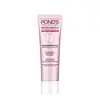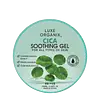What's inside
What's inside
 Key Ingredients
Key Ingredients

 Benefits
Benefits

 Concerns
Concerns

 Ingredients Side-by-side
Ingredients Side-by-side

Water
Skin ConditioningCyclopentasiloxane
EmollientButylene Glycol
HumectantNiacinamide
SmoothingGlycerin
HumectantDimethicone
EmollientPotassium Chloride
4-Ethylresorcinol
AntimicrobialCeramide NP
Skin ConditioningCeramide AP
Skin ConditioningCeramide EOP
Skin ConditioningBifida Ferment Lysate
Skin ConditioningSodium Hyaluronate
HumectantSodium Hyaluronate Crosspolymer
HumectantHydrolyzed Sodium Hyaluronate
Skin ConditioningSodium Acetylated Hyaluronate
HumectantCystine
MaskingGlycine
BufferingSodium PCA
HumectantCholesterol
EmollientDimethicone/PEG-10/15 Crosspolymer
Phenoxyethanol
PreservativeParfum
MaskingPEG-9 Polydimethylsiloxyethyl Dimethicone
EmulsifyingDisodium EDTA
PEG-4 Laurate
EmulsifyingDipropylene Glycol
HumectantIodopropynyl Butylcarbamate
PreservativePotassium Hydroxide
BufferingSodium Citrate
BufferingTocopherol
AntioxidantSodium Hydroxide
BufferingPentylene Glycol
Skin ConditioningSodium Lauroyl Lactylate
EmulsifyingPhytosphingosine
Skin ConditioningEthylhexylglycerin
Skin ConditioningXanthan Gum
EmulsifyingCarbomer
Emulsion StabilisingSodium Benzoate
MaskingWater, Cyclopentasiloxane, Butylene Glycol, Niacinamide, Glycerin, Dimethicone, Potassium Chloride, 4-Ethylresorcinol, Ceramide NP, Ceramide AP, Ceramide EOP, Bifida Ferment Lysate, Sodium Hyaluronate, Sodium Hyaluronate Crosspolymer, Hydrolyzed Sodium Hyaluronate, Sodium Acetylated Hyaluronate, Cystine, Glycine, Sodium PCA, Cholesterol, Dimethicone/PEG-10/15 Crosspolymer, Phenoxyethanol, Parfum, PEG-9 Polydimethylsiloxyethyl Dimethicone, Disodium EDTA, PEG-4 Laurate, Dipropylene Glycol, Iodopropynyl Butylcarbamate, Potassium Hydroxide, Sodium Citrate, Tocopherol, Sodium Hydroxide, Pentylene Glycol, Sodium Lauroyl Lactylate, Phytosphingosine, Ethylhexylglycerin, Xanthan Gum, Carbomer, Sodium Benzoate
Water
Skin ConditioningCentella Asiatica Extract
CleansingButylene Glycol
HumectantGlycerin
HumectantCalendula Officinalis Extract
Skin ConditioningCarbomer
Emulsion StabilisingArginine
MaskingCaprylyl Glycol
EmollientPhenyl Trimethicone
Skin ConditioningPentylene Glycol
Skin Conditioning1,2-Hexanediol
Skin ConditioningCitrus Aurantium Bergamia Fruit Oil
MaskingMadecassoside
AntioxidantAsiaticoside
AntioxidantAsiatic Acid
Skin ConditioningMadecassic Acid
Skin ConditioningPropolis Extract
Skin ConditioningAnthemis Nobilis Flower Extract
MaskingCalendula Officinalis Flower Extract
MaskingMentha Piperita Leaf Extract
Skin ConditioningThymus Vulgaris Extract
PerfumingChrysanthemum Parthenium Extract
Skin ConditioningLippia Citriodora Leaf Extract
AstringentBellis Perennis Flower Extract
Skin ConditioningOriganum Vulgare Leaf Extract
Skin ConditioningSalvia Officinalis Leaf Extract
CleansingUrtica Dioica Extract
AstringentHouttuynia Cordata Extract
Skin ConditioningEthylhexylglycerin
Skin ConditioningPEG-60 Hydrogenated Castor Oil
EmulsifyingHydroxyacetophenone
AntioxidantDisodium EDTA
Limonene
PerfumingLinalool
PerfumingWater, Centella Asiatica Extract, Butylene Glycol, Glycerin, Calendula Officinalis Extract, Carbomer, Arginine, Caprylyl Glycol, Phenyl Trimethicone, Pentylene Glycol, 1,2-Hexanediol, Citrus Aurantium Bergamia Fruit Oil, Madecassoside, Asiaticoside, Asiatic Acid, Madecassic Acid, Propolis Extract, Anthemis Nobilis Flower Extract, Calendula Officinalis Flower Extract, Mentha Piperita Leaf Extract, Thymus Vulgaris Extract, Chrysanthemum Parthenium Extract, Lippia Citriodora Leaf Extract, Bellis Perennis Flower Extract, Origanum Vulgare Leaf Extract, Salvia Officinalis Leaf Extract, Urtica Dioica Extract, Houttuynia Cordata Extract, Ethylhexylglycerin, PEG-60 Hydrogenated Castor Oil, Hydroxyacetophenone, Disodium EDTA, Limonene, Linalool
 Reviews
Reviews

Ingredients Explained
These ingredients are found in both products.
Ingredients higher up in an ingredient list are typically present in a larger amount.
Butylene Glycol (or BG) is used within cosmetic products for a few different reasons:
Overall, Butylene Glycol is a safe and well-rounded ingredient that works well with other ingredients.
Though this ingredient works well with most skin types, some people with sensitive skin may experience a reaction such as allergic rashes, closed comedones, or itchiness.
Learn more about Butylene GlycolCarbomer is a polymer of acrylic acid. Its main role is to create a gel consistency.
A high amount of carbomer can cause pilling or balling up of products. Don't worry, most products contain 1% or less of carbomer.
Disodium EDTA plays a role in making products more stable by aiding other preservatives.
It is a chelating agent, meaning it neutralizes metal ions that may be found in a product.
Disodium EDTA is a salt of edetic acid and is found to be safe in cosmetic ingredients.
Learn more about Disodium EDTAEthylhexylglycerin (we can't pronounce this either) is commonly used as a preservative and skin softener. It is derived from glyceryl.
You might see Ethylhexylglycerin often paired with other preservatives such as phenoxyethanol. Ethylhexylglycerin has been found to increase the effectiveness of these other preservatives.
Glycerin is already naturally found in your skin. It helps moisturize and protect your skin.
A study from 2016 found glycerin to be more effective as a humectant than AHAs and hyaluronic acid.
As a humectant, it helps the skin stay hydrated by pulling moisture to your skin. The low molecular weight of glycerin allows it to pull moisture into the deeper layers of your skin.
Hydrated skin improves your skin barrier; Your skin barrier helps protect against irritants and bacteria.
Glycerin has also been found to have antimicrobial and antiviral properties. Due to these properties, glycerin is often used in wound and burn treatments.
In cosmetics, glycerin is usually derived from plants such as soybean or palm. However, it can also be sourced from animals, such as tallow or animal fat.
This ingredient is organic, colorless, odorless, and non-toxic.
Glycerin is the name for this ingredient in American English. British English uses Glycerol/Glycerine.
Learn more about GlycerinPentylene glycol is typically used within a product to thicken it. It also adds a smooth, soft, and moisturizing feel to the product. It is naturally found in plants such as sugar beets.
The hydrophilic trait of Pentylene Glycol makes it a humectant. As a humectant, Pentylene Glycol helps draw moisture from the air to your skin. This can help keep your skin hydrated.
This property also makes Pentylene Glycol a great texture enhancer. It can also help thicken or stabilize a product.
Pentylene Glycol also acts as a mild preservative and helps to keep a product microbe-free.
Some people may experience mild eye and skin irritation from Pentylene Glycol. We always recommend speaking with a professional about using this ingredient in your routine.
Pentylene Glycol has a low molecular weight and is part of the 1,2-glycol family.
Learn more about Pentylene GlycolWater. It's the most common cosmetic ingredient of all. You'll usually see it at the top of ingredient lists, meaning that it makes up the largest part of the product.
So why is it so popular? Water most often acts as a solvent - this means that it helps dissolve other ingredients into the formulation.
You'll also recognize water as that liquid we all need to stay alive. If you see this, drink a glass of water. Stay hydrated!
Learn more about Water